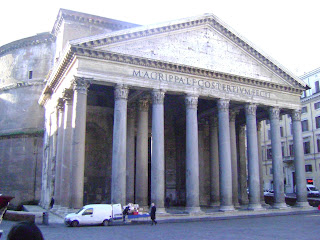 |
| Pantheon entrance |
Our blog is about our travels. We are Małgorzata and Daniel, a young, 'mixed', Polish-Hungarian couple. We love traveling and are trying to be brave enough to try new ways of traveling and getting as close to other cultures as we can.
Tuesday, December 28, 2010
Pantheon
Labels:
aerial view,
Barry Scharf,
Chiesa Santa Maria dei Martiri,
christian,
Italia,
Italy,
oculus,
Olaszország,
pagan,
Pantheon,
Roma,
Róma,
Rome,
Santa Maria Rotonda
Monday, December 27, 2010
Nimes - french city with roman spirit
 Nimes is a city situated in south-east France, found by Celts and led by the Roman Empire from 120 B.C. Interesting story is connected with city's emblem. Roman's emperors who were fighting in Egypt many times after fight settled in Nimes, from there come sign of crocodile and palm (crocodile and palm were associated to Egypt of course, beside that palm symbolizes also victory). Inscription "COLNEM" from emblem was meant for Colonia Nemausus, meaning the 'colony' of 'Nemausus'. In one of city square we can find lovely fountain with a crocodile (if You try a little You can jump in and ride on a crocodile:). Roman control was ended by the Visigoths in 473 AD. Nimes is the capital of the Gard department in the Languedoc-Roussilon region. Through the city leads the railway of TGV line to Paris and Lyon.
Nimes is a city situated in south-east France, found by Celts and led by the Roman Empire from 120 B.C. Interesting story is connected with city's emblem. Roman's emperors who were fighting in Egypt many times after fight settled in Nimes, from there come sign of crocodile and palm (crocodile and palm were associated to Egypt of course, beside that palm symbolizes also victory). Inscription "COLNEM" from emblem was meant for Colonia Nemausus, meaning the 'colony' of 'Nemausus'. In one of city square we can find lovely fountain with a crocodile (if You try a little You can jump in and ride on a crocodile:). Roman control was ended by the Visigoths in 473 AD. Nimes is the capital of the Gard department in the Languedoc-Roussilon region. Through the city leads the railway of TGV line to Paris and Lyon. |
| Nimes Amphitheatrum (fot. Przemysław Sakrajda) |
 |
| Nimes , Roman Temple Maison Carrée (fot. ChrisO) nowadays after renovation |
Small Roman Temple also built in the first century, dedicated to sons of Agrippa. Nowadays inside there is a little cinema where You can see story-of-history of Nimes in 3D. Personally i think that it's a fail, we couldn't visit temple from inside without buying ticket to cinema. In XVI century people started to call this temple "Maison Carrée" which in french language means "Square House". In the roman times it was placed in the middle of forum.
Besides these remains in Nimes You can see also:
-La Temple De Diane (dedicated to Octawian August and his family)
-Tour Magne (roman tower to observe)
-Ancient Gate to city (the Porta Augusta and the Porte de France)
-Castellum Divisorium (remains of aqueduct)
-Pont du Gard - ancient aqueduct situated 20 kilometers away from the city (really worth to see) nowadays used as a bridge.
-Catedra Notre Dame et Saint Castor built in 1096
-Beffroi (tower from 15th-century)
- Jardins de la Fontaine (Gardens of the Fountain) from 18th-century
Labels:
amphitheater,
amphitheatre,
Col Nem,
coloumn,
crocodile,
France,
nim,
Nimes,
Nîmes,
nimm,
palm,
Roma,
Roman Empire
Saturday, December 25, 2010
Roman Empire at present
Present countries of the former Roman Empire
(from 117 AD, when the Emire had the largest territory ever)
Albania (100% of territory was part of the Roman Emire)
Algeria
Andorra (100% of territory was part of the Roman Emire)
Armenia
Austria
Azerbaijan
Belgium
Bosnia and Herzegovina (100% of territory was part of the Roman Emire)
Bulgaria (100% of territory was part of the Roman Emire)
Croatia (100% of territory was part of the Roman Emire)
Cyprus (100% of territory was part of the Roman Emire)Croatia (100% of territory was part of the Roman Emire)
Egypt
France (100% of territory was part of the Roman Emire)
Georgia
Germany
Greece (100% of territory was part of the Roman Emire)
Hungary
Iraq
Israel (100% of territory was part of the Roman Emire)
Italy (100% of territory was part of the Roman Emire)
Jordan
Kosovo (100% of territory was part of the Roman Emire)
Lebanon
Libya
Liechtenstein (100% of territory was part of the Roman Emire)
Luxembourg (100% of territory was part of the Roman Emire)
Macedonia (100% of territory was part of the Roman Emire)
Malta (100% of territory was part of the Roman Emire)
Moldova
Monaco (100% of territory was part of the Roman Emire)
Montenegro (100% of territory was part of the Roman Emire)
Morocco
Netherlands
Palestinian National Authority
Portugal
Romania
San Marino
Saudi Arabia
Serbia (100% of territory was part of the Roman Emire)
Slovakia
Slovenia (100% of territory was part of the Roman Emire)
Spain (100% of territory was part of the Roman Emire)
Switzerland
Syria
Tunisia
Turkey (100% of territory was part of the Roman Emire)
Ukraine
United Kingdom
Vatican City (100% of territory was part of the Roman Emire)
Subscribe to:
Comments (Atom)